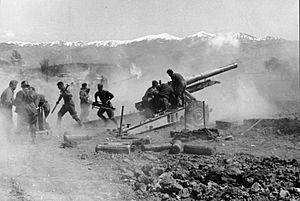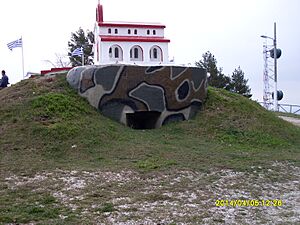Metaxas Line facts for kids
Quick facts for kids Metaxas Line |
|
|---|---|
| Northeastern Greece | |

Dragon's teeth along the Metaxas line, near the Greek-Bulgarian border
|
|
| Type | Defensive line |
| Site information | |
| Controlled by | Greece |
| Open to the public |
Yes |
| Site history | |
| Built | 1936–1941 |
| In use | 1936–1945 |
| Materials | Concrete and steel |
| Battles/wars | Battle of Greece in World War II
|
The Metaxas Line (Greek: Γραμμή Μεταξά, Grammi Metaxa) was a strong chain of forts and tunnels built in northeastern Greece. It was designed to protect Greece from a possible invasion by Bulgaria, especially after Bulgaria started rebuilding its army.
The line was named after Ioannis Metaxas, who was the Prime Minister of Greece at the time. It mostly consists of tunnels that led to observation posts, gun positions, and machine gun nests. These buildings were made so strongly that they are still standing today. Some parts of the Metaxas Line are even still used by the military, and others are open for people to visit.
The Metaxas Line has 21 separate fortification complexes. The biggest one is Fort Roupel, which covers about 6.1 kilometers (3.8 miles) of the total 155-kilometer (96-mile) line. It was built high up on a mountain at 322 meters (1,056 feet). When the forts were first built, they mostly used oil lamps for light. Generators were also installed. Today, the forts have regular electricity, but they still have generators as a backup. Air flowed through the forts naturally and with special systems. Water was brought in through pipes. Building the Metaxas Line took four years and cost a lot of money back then.
Forts of the Metaxas Line
The Metaxas Line is made up of 21 forts. They are listed here from west to east along the border between Greece and Bulgaria.
- Popotlivitsa (Ποποτλίβιτσα)
- Istibey (Ιστίμπεη)
- Kelkagia (Κελκαγιά)
- Arpalouki (Αρπαλούκι)
- Paliouriones (Παληουριώνες)
- Roupel (Ρούπελ)
- Karatas (Καρατάς)
- Kali (Κάλη)
- Persek (Περσέκ)
- Babazora (Μπαμπαζώρα)
- Maliaga (Μαλιάγκα)
- Perithori (Περιθώρι)
- Partalouska (Παρταλούσκα)
- Ntasavli (Ντάσαβλη)
- Lisse (Λίσσε)
- Pyramidoeides (Πυραμιδοειδές)
- Kastilo (Καστίλο)
- Agios Nikolaos (Αγιος Νικόλαος)
- Bartiseva (Μπαρτίσεβα)
- Echinos (Εχίνος)
- Nymfaia (Νυμφαία)
Building the Line
Before World War II started, the existing forts at Roupel were thought to be too weak. So, in 1935, Greece decided to build many more forts. They wanted to build them all along the northern Greek border. Work began in 1936 near Kerkini.
The original plan was to extend the forts all the way to Ormenio. However, Greece became involved in World War II in 1940. This meant the Metaxas Line could not be fully finished. When the war began, the line only reached Komotini in Thrace. It was about 155 kilometers (96 miles) long.
The Battle of the Metaxas Line
The Metaxas Line was similar to the Maginot Line in France. Both were strong defensive lines. However, the Metaxas Line was outflanked by German forces. This happened when the Germans invaded Greece in April 1941 by going through Yugoslavia.
The German army attacked the Metaxas Line on April 6, 1941, before dawn. The Greek soldiers, led by General Konstantinos Bakopoulos, fought back very bravely. After three days of fighting, the Germans had only made small progress.
However, a German tank division went around the line. They crossed the border from Yugoslavia and quickly captured Thessaloniki on April 9. Because Thessaloniki was captured, the Greek army defending the Metaxas Line had to surrender on April 10. This ended the Battle of the Metaxas Line.
German General Wilhelm List led the attack against the Metaxas Line. He was very impressed by the courage of the Greek soldiers. He did not take them as prisoners of war. Instead, he allowed them to leave with their war flags, as long as they gave up their weapons and supplies. He even ordered his own soldiers to salute the Greek soldiers. There were not many Greek troops defending the line. Most of the Greek army was fighting against the Italians on the Albanian front.
See also
- Greco-Italian War
- 4th of August Regime



